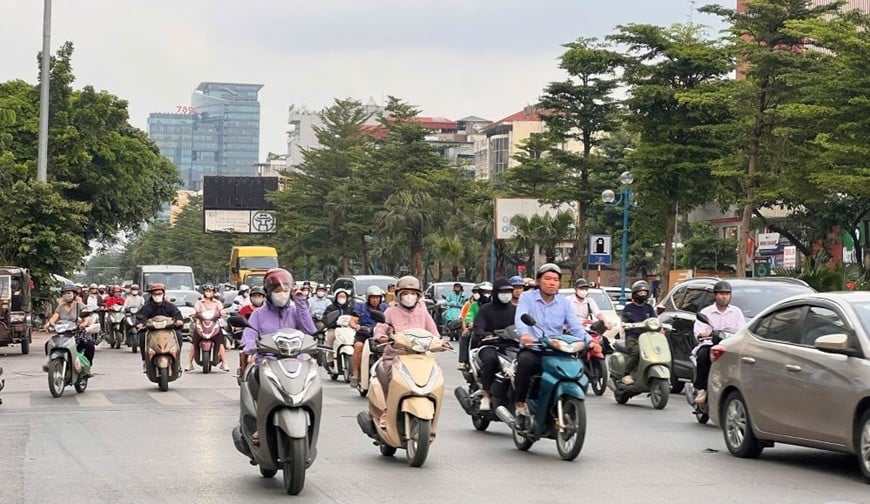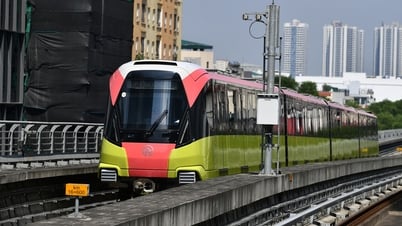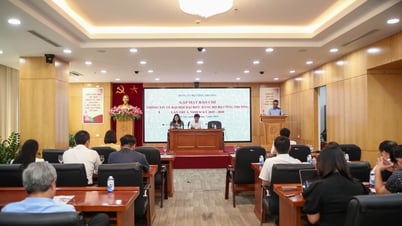As a popular means of transportation and the main means of livelihood for millions of people, motorbikes and scooters in Vietnam are currently irreplaceable. In the context of increasingly high demands on the quality of the living environment, controlling emissions from motorbikes and scooters is necessary. However, the implementation needs to be carefully calculated and have a suitable roadmap so as not to create additional burdens for low-income groups.
Math problems from numbers
According to statistics from the National Traffic Safety Committee, as of September 2024, there were more than 77 million motorbikes and motorbikes in circulation nationwide; in Hanoi and Ho Chi Minh City alone, these vehicles accounted for more than 85% of the total number of personal vehicles.
Results from three emission measurement programs in Hanoi, Ho Chi Minh City and Da Nang show that vehicles over 10 years old often have emissions exceeding standards. In Hanoi, this group of vehicles accounts for 72.58%, in Ho Chi Minh City it is 68% and in Da Nang it is more than 59%. Old motorbikes are identified as a significant source of CO, HC and NOx emissions, contributing to urban air pollution and affecting human health.

Faced with this reality, the Ministry of Agriculture and Environment (MARD) has developed a roadmap for applying the National Technical Regulation on emissions for motorbikes and scooters in circulation in Vietnam, aiming to increase periodic emissions inspections and eventually eliminate substandard vehicles from circulation. According to the draft, emissions inspections will begin from July 1, 2027 in Hanoi and Ho Chi Minh City, then expand to the following localities: Da Nang, Hai Phong, Can Tho, Hue from July 1, 2028 and apply nationwide from July 1, 2030 (depending on specific conditions).
Speaking to us, Professor Dang Hung Vo, former Deputy Minister of Natural Resources and Environment (now the Ministry of Agriculture and Rural Development), said: “If we do not intervene decisively in the emission source of old motorbikes, it will be very difficult for Vietnam to achieve its goals of reducing emissions and improving public health. This is a must-do, but it is necessary to carefully study social consensus and ensure feasibility.” According to experts, in the context that many countries in the region such as Thailand and Indonesia have implemented motorbike emission testing, Vietnam cannot stand aside. However, the application must take into account the average income level, vehicle maintenance conditions and the readiness of the testing infrastructure system.
When people are still wondering
The policy of reducing emissions is correct, but the implementation is causing many people, especially freelancers and low-income earners, to express concern. At a repair shop in Bo De ward (Hanoi), Nguyen Van Huy (26 years old), a technology driver, is changing spark plugs and maintaining his motorbike that is more than 10 years old. "My parents bought this motorbike in 2008. I use it to go to school and then work as a technology driver. The motorbike still works well and is smokeless. If I am forced to inspect and scrap it because it is old, how will I make a living?", said Huy.
Similarly, Ms. Nguyen Thi Lanh (52 years old), from Hau Loc commune (Thanh Hoa), a street vendor in Hanoi's Old Quarter, shared: "Street vendors don't make much profit. If I have to change to a new motorbike just because the old one fails the emission test, I don't know how to cope." As a regular customer of Ms. Lanh, Ms. Tran Khanh Huyen (29 years old), an office worker in Cua Nam ward (Hanoi), also expressed her concern: "My family has 3 motorbikes, two of which are old but still work well. If we ban the use of old motorbikes, it will be really inconvenient and costly."
The general sentiment of many people is that they are concerned that emission control regulations will be applied rigidly, such as scrapping vehicles based on their “age” instead of assessing their actual condition. This can easily lead to the scrapping of vehicles that are still in good condition, disrupting work, seriously affecting livelihoods, especially for the poor, students, and the elderly.
Policy needs to go hand in hand with social security solutions
According to Professor Dang Hung Vo, if well maintained, many old motorbikes still have emission levels within the allowable threshold. Therefore, instead of rigid regulations based on age, we should actually check the emissions of each vehicle to classify and have appropriate handling directions. From a policy perspective, he further suggested: "The roadmap should be accompanied by solutions to support people, especially low-income groups who have almost no other alternatives than old motorbikes. They need to be supported with free inspections, be able to access preferential vehicle exchange programs or subsidize environmentally friendly vehicles such as electric vehicles."
In addition, Mr. Hung proposed the need to synchronously implement long-term solutions such as: Development public transport, integrating emission testing into vehicle registration, insurance or circulation licensing activities, avoiding creating additional administrative burdens, strictly managing testing centers, raising environmental protection awareness in the community. Along with that, it is necessary to be transparent about costs and procedures, avoiding policies turning into "sub-licenses" that cause inconvenience and loss of trust from people. These will contribute to increasing feasibility, minimizing disruption in people's lives.
Controlling emissions from motorbikes and scooters, if implemented effectively, will contribute to improving the quality of urban life, protecting the environment and public health. For the policy to be effective and put into practice, it needs a flexible, transparent roadmap, substantial support and the support of the people.
Source: https://baolangson.vn/can-lo-trinh-phu-hop-linh-hoat-de-khong-tao-them-ganh-nang-5052961.html





































































































Comment (0)